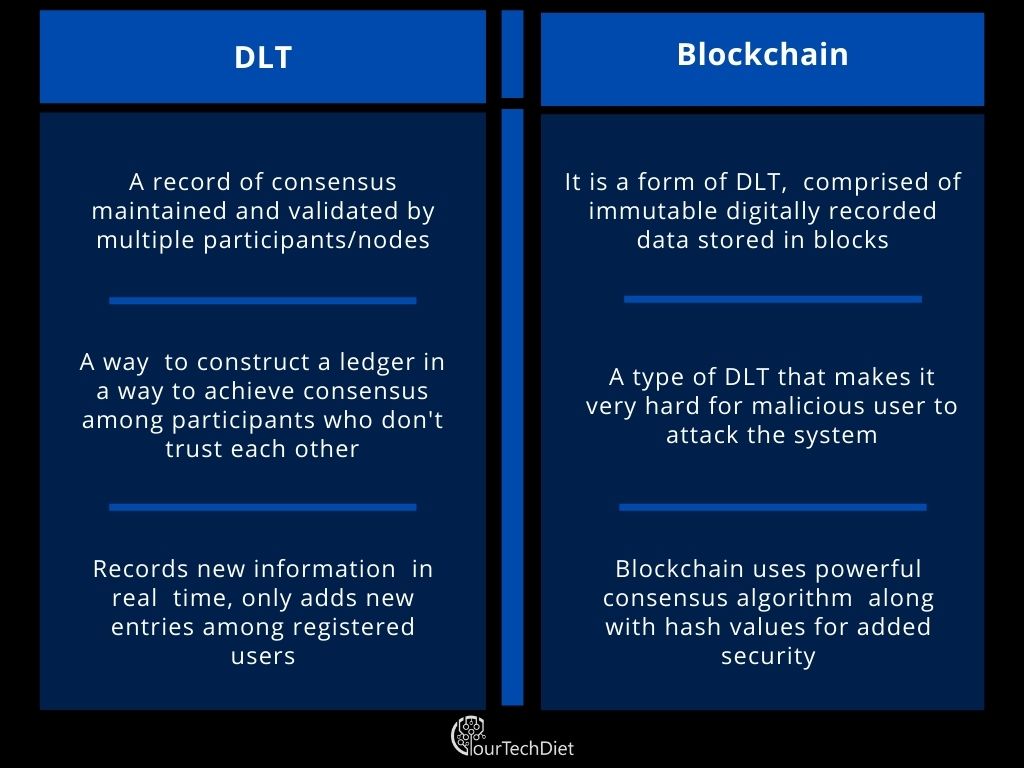Blockchain and distributed ledger are often used interchangeably, but there are nuanced differences between the two. While blockchain is a specific type of distributed ledger, a distributed ledger is a broader concept that encompasses various technological approaches for recording and sharing transactions in a decentralized manner.
Both blockchain and distributed ledger utilize cryptographic techniques and decentralized consensus mechanisms, but blockchain typically refers to a specific format of a distributed ledger that records transactions in blocks, which are then linked together in a chain, whereas a distributed ledger can take on different forms and structures.
We will delve into the distinctions between blockchain and distributed ledger, exploring their unique characteristics, use cases, and potential implications for various industries and applications.
Key Differences
Blockchain vs Distributed Ledger: The key differences between blockchain and distributed ledger are crucial to understand. In terms of centralization vs decentralization, blockchain technology operates on a decentralized network, while distributed ledger technology can operate in either a centralized or decentralized manner, offering more flexibility. When it comes to consensus mechanisms, blockchain typically uses Proof of Work or Proof of Stake, whereas distributed ledger can utilize a range of consensus algorithms, providing varied options for securing the network.

Security Features
Blockchain technology provides immutability through the use of cryptographic hashing, making it nearly impossible to alter transaction records. This feature ensures the trustworthiness of data, offering a secure and transparent ledger. Additionally, encryption techniques within blockchain add an extra layer of security, safeguarding sensitive information. On the other hand, distributed ledger also offers immutability and enhanced security measures through cryptographic protocols. These features ensure the trust and integrity of data within a distributed network, providing resistance against unauthorized modifications.
Use Cases
Blockchain and distributed ledger have diverse use cases. Blockchain is often utilized in cryptocurrency transactions due to its secure and transparent nature, while distributed ledger finds applications in supply chain management and healthcare for its efficient data sharing and decentralization.
Both technologies offer unique advantages in various industries.
| Blockchain Applications: | Distributed Ledger Applications: |
| Supply chain tracking and management. | Transparent and secure record-keeping. |
| Cryptocurrency transactions. | Identity verification and authentication. |
| Smart contracts for automated agreements. | Document verification and digital signatures. |
Scalability
Blockchain and distributed ledger technology (DLT) have gained prominence in recent years, offering solutions to various scalability concerns. Scalability is a crucial aspect to consider for any technology. When it comes to transaction speed, blockchain and DLT differ in their approaches. While blockchains, such as Bitcoin and Ethereum, are known for their slower transaction speeds due to the extensive verification process, DLT offers faster transaction times.
As network size plays a significant role in scalability, DLT can handle a larger number of transactions compared to traditional blockchains. The scalability of DLT is attributed to its ability to process multiple transactions in parallel, coupled with its consensus mechanisms that allow for increased throughput. Moreover, DLT’s scalability can be further enhanced by utilizing sharding techniques, where the network is divided into smaller sections to process transactions more efficiently.
Regulatory Implications
The regulatory implications of blockchain and distributed ledger technologies are vast and complex. Compliance challenges arise due to the unique nature of these technologies and the decentralized nature of the networks they operate on.
When it comes to legal considerations, businesses need to navigate various regulations that may differ across jurisdictions. As blockchain and distributed ledgers can operate across borders, understanding and complying with relevant regulations becomes critical. Businesses must ensure that their operations are in line with data protection laws, anti-money laundering regulations, and securities laws, among others.
Moreover, the immutability and transparency of blockchain and distributed ledger technologies raise questions about privacy and data protection. Entities utilizing these technologies must carefully consider the various legal aspects pertaining to personal data and ensure compliance with applicable laws.
In addition, contractual agreements and smart contracts on these platforms may require legal clarification and validation. Entities must navigate the legal nuances associated with these agreements and ensure they are enforceable under relevant legal frameworks.
Overall, the regulatory implications of blockchain and distributed ledger technologies are still evolving, and businesses must stay informed and proactive to address compliance challenges effectively.
Future Prospects
Blockchain technology offers secure and transparent transactions through cryptographic algorithms.
Distributed ledger technology promotes trust among network participants through decentralized consensus mechanisms.
Industry sectors like finance and supply chain are increasingly embracing blockchain solutions.
Continuous advancements are enhancing the scalability and interoperability of distributed ledger systems.

Frequently Asked Questions Of Blockchain Vs Distributed Ledger
What Is The Difference Between Blockchain And Distributed Ledger?
Blockchain is a type of distributed ledger technology. While blockchain is a decentralized and tamper-proof database that stores information in blocks, distributed ledger refers to a system where multiple participants have access to a shared and synchronized digital record of transactions.
How Does A Distributed Ledger System Work?
In a distributed ledger system, transactions are recorded and verified by multiple participants on the network. Each participant maintains a copy of the ledger and updates it independently. Consensus algorithms ensure that all copies of the ledger stay synchronized and any changes are agreed upon by the network.
What Are The Advantages Of Using Blockchain?
Blockchain offers transparency, security, and immutability to transactions. It eliminates the need for intermediaries, reduces fraud, and improves efficiency. Blockchain also enables the creation of smart contracts and provides a decentralized platform for applications and services.
How Is A Distributed Ledger Different From A Centralized Database?
Unlike a centralized database, where a single entity controls and manages the record of transactions, a distributed ledger is shared among multiple participants. This eliminates the need for a central authority, improves transparency, and reduces the risk of data manipulation or fraud.
Conclusion
While blockchain and distributed ledger share similarities, they serve distinct purposes. Understanding their differences is crucial for choosing the right technology. Both offer innovative solutions, but the key lies in selecting the most suitable option for your specific needs and goals.
Choose wisely.

